Relationship Between a Declining Birthrate/Ageing Population and Happiness
Tsukasa Matsuura/Associate Professor, Faculty of Economics, Chuo University
Fields of Interest: Population Economics and Labor Economics
1. Population ageing in the world and Japan
Population ageing is progressing rapidly throughout the world. According to the latest (2022) United Nations World Population Prospects, in 2002, the world's ageing rate (percentage of the population aged 65 and over) exceeded 7%, and the world as a whole entered the phase of an ageing society. In addition, as shown in Figure 1, the ageing rate will exceed 10% in 2023, and researchers expect that population ageing will continue to progress all over the world. A major factor in ageing of the world population is the ageing of East Asia, a region which is expected to experience rapid ageing in the future. In 1997, the ageing rate in East Asia exceeded 7%, making the region an ageing society. In 2020, the ageing rate exceeded 14% and the region entered into an aged society. The ageing population in East Asia will continue to grow and is expected to exceed 30% by 2050.
Figure 1 Population ageing in the world, East Asia, and Japan
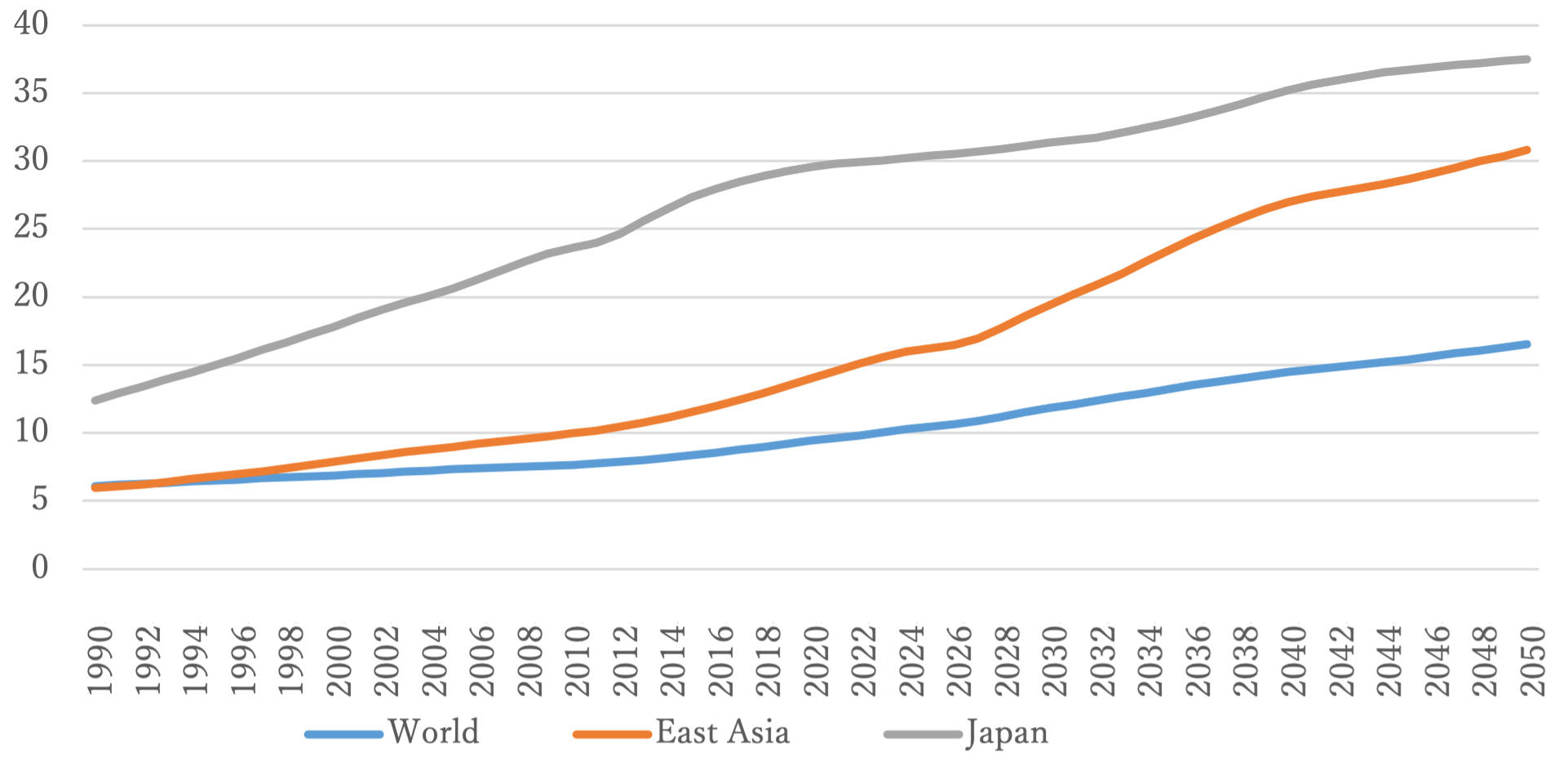
Among East Asian countries, Japan has the oldest population by a large margin. The ageing population in Japan is expected to exceed 30%, making it the country with the highest ageing rate in the world. Japan's population is expected to continue to age, reaching nearly 40% by 2050. Even within Japan, there are regional differences in the progress of ageing. As shown in Figure 2, the prefectures where the aging rate exceeds 35% in 2020 are Akita Prefecture and Kochi Prefecture, while the ageing rate is low in metropolitan areas. In 2045, overall population ageing progresses, and researchers expect that the Tohoku region in particular will experience a marked increase in population ageing. For example, Akita Prefecture is expected to have an ageing rate of over 50% by 2045, with more than half of the population aged 65 and over.
Figure 2 Ageing rate by prefecture: 2020
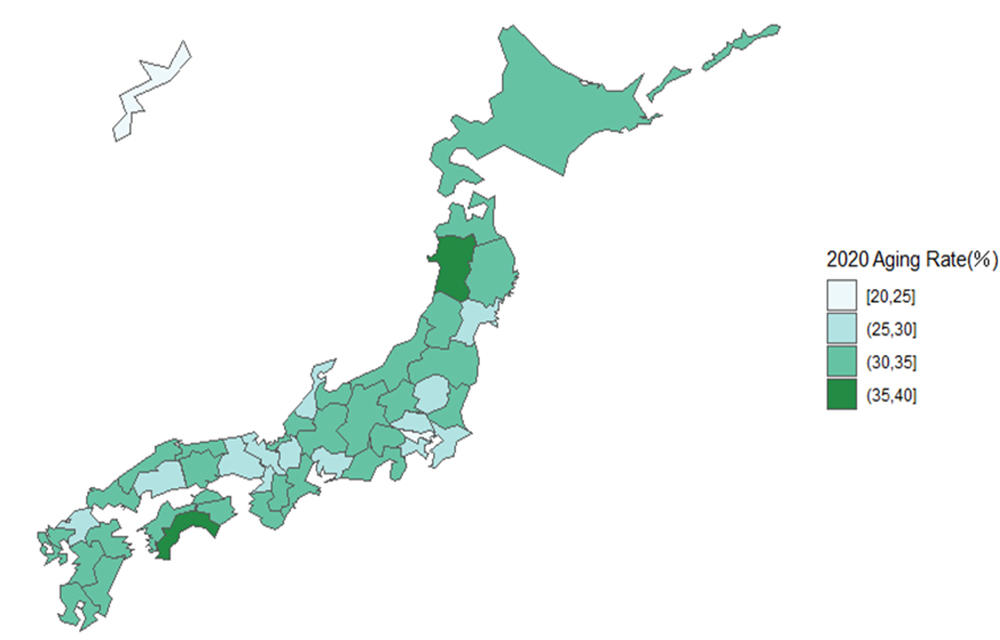
Figure 3 Ageing rate by prefecture: 2045
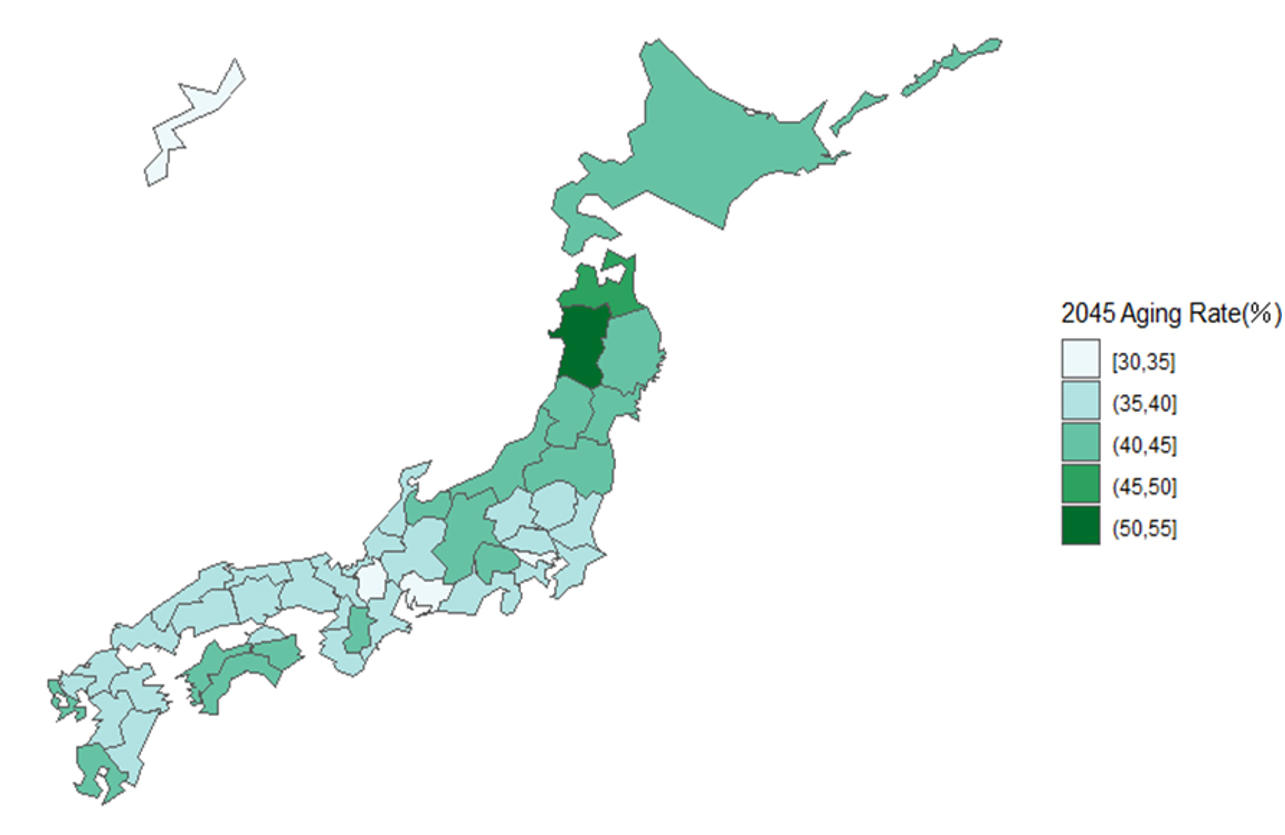
2. Increase of elderly persons living alone
In contrast, in metropolitan areas such as Tokyo, Osaka Prefecture, and Aichi Prefecture, the ageing rate will be around 30% even in 2045. However, population ageing is still a serious issue even for these large metropolitan areas. As the population ages, the number of elderly persons living alone will also increase. In particular, such households are expected to rise significantly in aforementioned large metropolitan areas. As shown in Figure 4, the number of elderly persons living alone aged 65 and over exceeds one million in Tokyo, and 27.7% of the elderly aged 65 and over are expected to be living alone. The number of elderly persons living alone will increase in large metropolitan areas, and it is predicted that the number will rise in both Osaka Prefecture and Kanagawa Prefecture, ultimately exceeding 500,000.
Figure 4 Forecasted number of elderly persons living alone in 2035
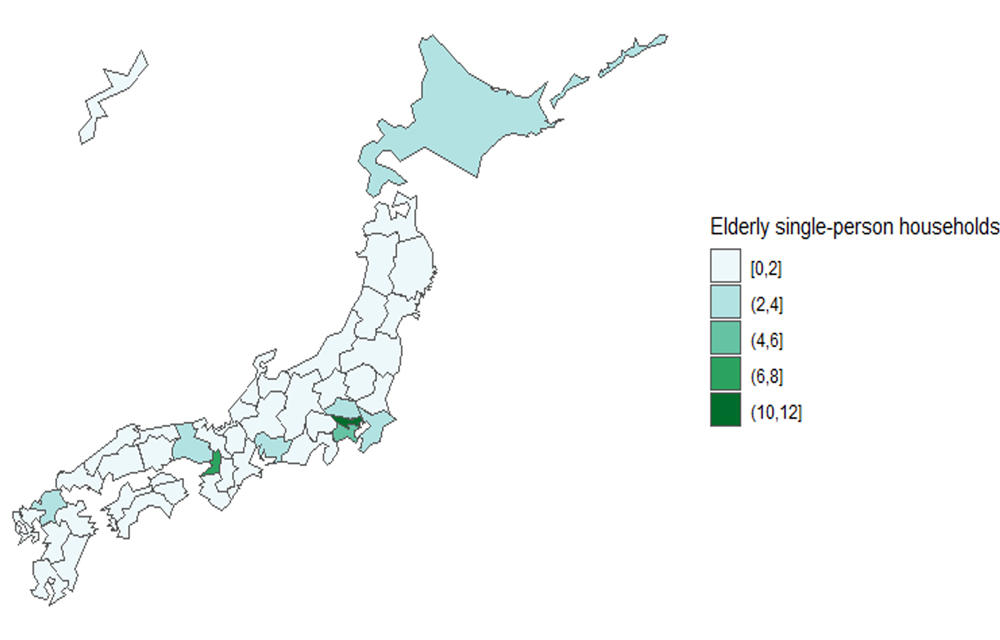
In this way, although the ageing rate is lower in large metropolitan areas than in rural areas, the increase in the absolute number of elderly people and increase in the number of single-person households will surely lead to an increase in the number of elderly persons living alone.
3. Poverty and level of happiness in elderly persons living alone
What is the result of this trend toward an increase in the number of elderly persons living alone? Such households generally have a close relationship with poverty. Tachibanaki and Urakawa (2006) point out the high poverty rate among female elderly persons living alone. This means that the increase in the number of elderly persons living alone raises concerns about an increase in the poverty rate.
On the other hand, some researchers point out that such an increase is not necessarily a bad thing. Klinenberg (2012) emphasizes the positive proactive aspects; i.e., elderly persons living alone can secure privacy and decide independently on their lives. With this in mind, I cooperated with Professor Ma Xinxin of Hosei University in a study using data on Japanese and Chinese elderly people to understand the impact of living alone on elderly people's subjective well-being, such as happiness and life satisfaction. The results were published in an article by Matsuura and Ma (2022) in the Journal of Happiness Studies. In the case of China, we did not confirm that the fact of living alone had an impact on the subjective well-being of elderly men and women. However, in Japan, that fact had a positive impact on subjective well-being on elderly women, but a significantly negative impact on elderly men.
I also used the World Values Survey, which provides access to samples from countries around the world, to analyze changes in gender differences in the impact of being unmarried on subjective well-being, taking into account age, economic development stage, and era. I published the results in Matsuura (2022). My research indicated no gender difference in the impact of being unmarried on subjective well-being at a young age. Conversely, the negative effect of being unmarried on subjective well-being at the age of 60 or older is significantly higher for men. Furthermore, this trend is more pronounced in developed countries than in developing countries. Although this trend has weakened in recent years, even when using data from 2010 onwards, there is a significantly greater negative impact on subjective well-being when being unmarried in developed countries for men aged 60 and over than for women.
4. Relationships between having children and happiness
In this way, I have examined the current state of ageing societies based on elements of subjective well-being such as happiness and satisfaction. In demographics, the determinants of ageing are the birth rate and the increase in average life expectancy. Of these, the birth rate is the major factor that determines the ageing rate. The government is also promoting countermeasures against the declining birthrate in order to deal with the problem of an ageing population. In fact, the Kishida administration is advocating "a different dimension of countermeasures against the declining birthrate."
Low birth rates are a common trend not only in Japan but also in East Asia. In some years, the total (special) birth rate falls below 1.0 in South Korea, Taiwan, and Hong Kong. In contrast, many countries in Western Europe generally fluctuate between 1.5 and 2.0.
Therefore, I cooperated with Professor Junji Kageyama of Meikai University to verify the hypothesis that the impact of having children on parental satisfaction might be different in East Asia and Western Europe. The results were published in an article by Kageyama and Matsuura (2023). Our paper classified married women into four categories depending on whether or not they are employed and whether or not they have children. The base category is "Not Working/Not Parent (NW_NP)," and we then compared East Asia and Western Europe in terms of satisfaction regarding "Working/Not Parent (W_NP)," "Not Working/Parent (NW_P)," and "Working/Parent (W_P)."
The results are shown in Figure 5. In East Asia, in the 2010s, the level of satisfaction was remarkably lower for all categories other than Not Working/Not Parent. Conversely, this means that there was an extremely high level of satisfaction for Not Working/Not Parent. Compared to the 2000s, women's satisfaction with having children became lower in the 2010s, regardless of whether or not women were employed. On the other hand, women in Western Europe tend to be more satisfied with having children, a trend which is growing stronger in more recent years. This suggests that one of the reasons for the low birth rate in East Asia compared to Western Europe is a higher perceived burden of having children, particularly for women.
Figure 5 Impact of children on mother's level of life satisfaction: East Asia and Western countries
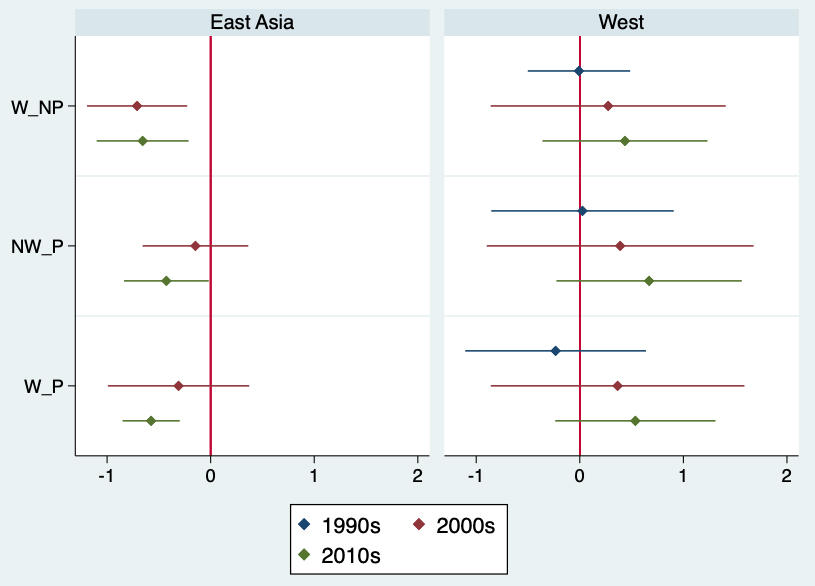
5. Summary
This article can be summarized as follows. The world as a whole is ageing, with East Asia being the main cause. Japan has the highest ageing rate of any country in the world, and this trend is expected to continue to accelerate in the future. This trend is also strong in rural areas. On the other hand, the number of elderly persons living alone is expected to increase in metropolitan areas. Although such households are a cause of poverty, they have a different impact on happiness between men and women. In the case of Japanese women, an increase of elderly persons living alone is not necessarily a factor in lower happiness levels. Furthermore, being unmarried causes a greater decline in happiness among men, and this gender gap becomes more pronounced as age increases, which is a global trend. The Japanese government strongly promotes measures to tackle the declining birthrate and ageing population. However, unlike countries in Western Europe, the burden felt by women in East Asia due to having children is increasing, which is also presumed to be one of the reasons for the low birth rate in East Asia.
【Reference Literature】
Tachibanaki T. and Urakawa K. (2006). Studies on Poverty in Japan , The University of Tokyo Press.
Kageyama. J. and Matsuura, T. (2023). How Do People in East Asia Feel About Parenthood and Work? Kageyama, J and Teramura, E. (eds). Perception of family and work in low-fertility East Asia. Springer.
Klinenberg, E. (2012). Going Solo: The extraordinary rise and surprising appeal of living alone. New York: Penguin Press.
Matsuura, T. & Ma, X. (2022). Living Arrangements and Subjective Well-being of the Elderly in China and Japan, Journal of Happiness Studies, 23(3), pp. 903-948.
Matsuura, T. (2022). Gender Difference in the Effect of Never Married on SWB, IERCU Discussion Paper 368 2022-04-26.
Tsukasa Matsuura/Associate Professor, Faculty of Economics, Chuo University
Fields of Interest: Population Economics and Labor EconomicsTsukasa Matsuura was born in Fukui Prefecture in 1977.
In 2001, he graduated from the School of Political Science and Economics, Waseda University.
In 2005, he completed the Master’s Program in the Graduate School of Economics, Kyoto University.
In 2008, he completed the Doctoral Program in the Graduate School of Economics, Kyoto University without obtaining a doctoral degree.
In 2011, he acquired a PhD in economics from the Graduate School of Economics, Kyoto University.Previous Position
Assistant Professor in the Faculty of Economics, Chuo University before assuming his current position in 2012.Book
Modern Population Economics (Nippon Hyoronsha, 2020).Referred Paper
His main papers include Matsuura and Ma (2022), Living Arrangements and Subjective Well-being of the Elderly in China and Japan, Journal of Happiness Studies, etc.








